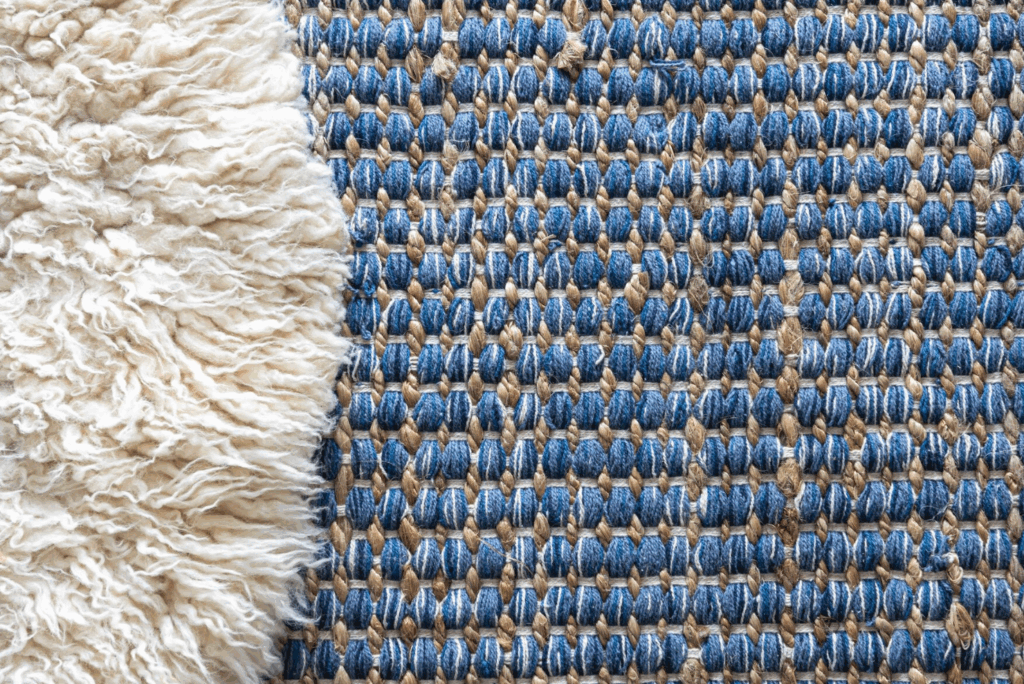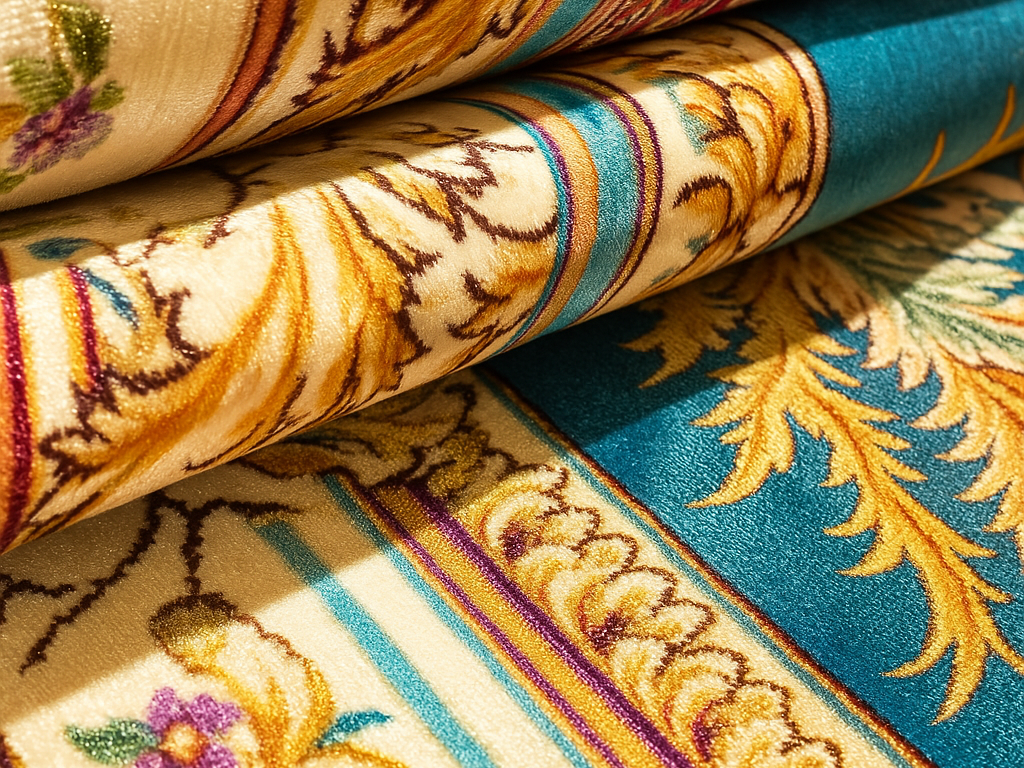高品質のエリアラグを選ぶとなると、最も一般的で贅沢な天然素材の選択肢はシルクとウールの2つです。Valhakでは、ラグの見た目が美しいだけでなく、お客様のライフスタイルや空間に合うよう、十分な情報を得た上で決定していただけるようお手伝いしています。この記事では、シルクとウールのラグを比較し、その素材、違い、どちらが良い選択か、お手入れ方法などをご紹介します。

1.素材を理解するシルクとウールの比較
シルクシルクとは何か、どのように振る舞うか
シルクは蚕(または他の昆虫)によって作られる天然のタンパク質繊維で、その光沢、繊細さ、きめの細かさから何千年もの間、珍重されてきた。敷物の世界では、"シルク絨毯"は通常、パイル(場合によっては土台)が絹糸でできているラグを指す。糸が非常に細いため、絹は非常に細かい織物と非常に滑らかな表面を可能にします。例えば、ある絨毯製作の資料では、「シルクの繊維はウールよりも細い」ため、「職人はより複雑で正確なパターンを織ることができる」と書かれています。また別の資料では、シルク絨毯の "光沢 "と "繊細さ "を強調しています。
しかし、シルクはよりデリケートでもあります。湿気、激しい足の運び、強い太陽光線、研磨剤入りのクリーニングなどはすべて、摩耗を早める可能性があります。あるクリーニングの専門家は、"シルクは水に濡れると、その強度が最大で20%失われる "と述べています。このような特徴から、シルクのラグは往来の少ない場所や装飾用に使われることが多いのです。
ウール:ウールとは何か、どのような性質か
ウールは間違いなくラグ界の主力商品です。ほとんどの ウールラグ は羊の毛から作られています(他の天然繊維との混紡やブレンドもあります)。ウールは厚みがあり、弾力性に富み、シルクの光沢に比べて表面がマットな仕上がりになります。例えば、あるガイドはウールを "長年愛されている......その耐久性、柔らかさ、暖かさで知られている "と呼んでいる。また、別の情報源では、ウールは交通量の多い用途に強いと強調しています。
羊の毛に含まれるラノリンはもともと汚れにくい性質を持っており、ウールの繊維は繰り返し使用することで耐久性を増す傾向がある。
2. シルクラグ対ウールラグ:どちらが良いか
正直な答えはこうだ: どちらが "良い "ということはない 他よりも。結局は スペース、予算、ライフスタイルに合うのはどちらか?.とはいえ、両者の主要な点を比較してみよう。

外観と美的インパクト
もし、あなたの第一の目標が すごい 見た目では、シルクのラグに軍配が上がります。繊維が細く、ノット数が多く、仕上げが洗練されているため、シルクの作品は非常に複雑な模様や鮮明なディテールを表現でき、輝きのある仕上げが目を引きます。例えば「シルクのラグはより光沢があり......1平方インチあたりのノット数が多いので、デザインがよりはっきりしています。
ウールラグの美しさは変わりませんが、リッチで質感があり、温かみがあり、足元が心地よくなることが多いのです。リッチな質感、暖かさ、そして多くの場合、足元の心地よさです。鮮やかな光沢には欠けるかもしれませんが、快適さ、実質、そしてクラシックなエレガンスをもたらしてくれます。ある記事にこうある:「大きな違いは......シルクは光沢があり、とても美しいこと。
性能(耐久性と実用性)
絨毯を人通りの多い場所(例えば、家族用)に置く場合 リビング(1)、(2)、(3)、(4) 玄関子供やペットが歩き回るスペースでは、一般的にウールが有利です。あるラグの専門家はこう言います:「性能に関してはウールの方がはるかに優れています。
対照的に、シルクはよりデリケートで、湿気や激しい足の動きによって平らになったり、摩耗したり、ダメージを受けたりしやすい。例えば「シルクのラグは...実はとてもデリケートです。人の出入りの少ない部屋に置くべきです。"
コストと価値
材料費、労働力(上質なシルクは手織りの方が時間がかかる)、希少性から、シルクのラグはプレミア価格がつくことが多い。ある情報筋によると、同じデザインでシルクの手織り絨毯は、ウール絨毯の「2倍から4倍」の値段がつくという。
ウールの絨毯は決して安くはないが(特に上質なもの 手織り 日常的な使用であれば、性能に比してウールの方がお得である。予算や実用性を重視するなら、ウールの方が賢明かもしれない。
長期使用と再販の考慮
人の出入りが多い環境でのウールラグは、適切にメンテナンスすれば、よく摩耗し、何十年も長持ちすることがよくあります。多くのウールラグは、良好な条件下では25~50年以上長持ちします。
シルクの絨毯は、慎重に(人の出入りの少ない場所で、注意深く)使うこともできます。 もちがいい-しかし、その誤差は小さくなります。もしシルクラグを間違った環境(例えば、人の出入りが多い場所、直射日光の当たる場所、濡れた場所)に置くと、性能が低下することがあります。長持ちさせるためにシルクラグを壁掛けにすることを勧める販売店もあります。
3. シルクのラグを選ぶとき
シルクのラグをお望みなら、シルクが本当に輝く(ダジャレではありません)シーンをご紹介しましょう:
- フォーマルな部屋または人通りの少ないゾーン:フォーマルを考える ダイニング書斎や、あまり人の出入りのない居間など。このような空間では、シルクのデリケートな性質が受け入れられ、その美しさという報酬を得ることができるのです。
- 美的センスのためのステートメント・ピース:ラグがセンターピースとして機能し、視覚的なフォーカスを集める装飾の一部となる場合(天井の高い部屋で、アートや照明がラグを見せるようにデザインされている場合など)、シルクが理想的です。
- 複雑なデザインと繊細な織りが重要な場合:シルクの糸は細いので、ノット数が多く、細かいデザイン、シャープなモチーフが可能です。最高の職人技を求めるなら、シルクはそれを可能にします。
- 洗練された美しさを引き立てる:ラグジュアリー、ミニマル、ハイエンドなインテリアで、ラグにもそのレベルを反映させたいなら、シルクがぴったり。
- 予算に余裕があり、慎重な使用が見込まれる場合:一般的にシルクはコストが高く、手入れも必要なため、シルクを選ぶということは、一定レベルのスチュワードシップを約束するということです。
シルク絨毯の敷き方
- 人通りの多い場所や、靴の出入りがあるドアの近くには置かない。
- 直射日光の当たる場所は避けてください(繊維の色あせや劣化の原因になります)。
- 摩擦や磨耗を減らすために、高品質のラグパッドを使用してください。
- 定期的にラグを回転させ、表面全体が均等になるようにします。
- クリーニングにはシルク繊維に詳しい専門家が必要かもしれません。あるクリーニングガイドによると、"熱湯、スチーム...はすべてシルクの絨毯の繊維に永久的なダメージを与える可能性がある "と警告しています。
もし、あなたが上記の項目のほとんどに当てはまるのであれば、シルクのラグは特別な投資であり、視覚的な資産となります。
4.ウールラグを選ぶとき
ウールが選ばれる理由はたくさんある。ここでは、ウールがより明確な選択肢となるシチュエーションを紹介しよう:
- 交通量の多い場所: 廊下リビングルーム、プレイルーム、オープンコンセプトのゾーン、人が頻繁に移動するスペースなど、ウールはそのために作られている。
- ファミリー、ペット、アクティブユース:お子様やペットがいる場合、頻繁に人が集まる場合、ウールは弾力性があり、日常的に使いやすい。
- 価値主導の決断:予算が重視される場合、あるいは1ドルあたり最高の性能を求める場合は、ウールが有利に働くことが多い。
- 耐久性と長期間の着用:最小限の手間で何十年も使えるラグをお望みなら、ウールなら安心です。
- 居心地の良い美しさと足元の快適さ:ラグに生活感(文字通り、寝転んだり、くつろいだり、足を運んだり)を求めるなら、ウールは暖かく、柔らかく、快適な感触を提供します。
ウールラグを敷くコツ
- 毛足が非常に太い場合は、家具が沈んだり、安定性に問題が生じたりしないことを確認してください。
- 定期的に掃除機をかけることをお勧めします(ビーターバーを強く設定しないこと)。例えば「ウールラグは毛足が太く丈夫で、耐久性に優れています。汚れが繊維に入り込むのを防ぐため、月に2回は掃除機をかけてください。
- ラグが動くのを防ぎ、寿命を延ばすには、ラグパッドをお使いください。
- 明るい場所にラグがある場合は、定期的にラグを回転させて、片面が他の面より日光や磨耗が強くならないようにしてください。
上記のいずれかに当てはまる場合、ウールの方がより賢く、より実用的で、なおかつ美しい選択になることが多い。
5.シルクとウールのラグ特有のケアとメンテナンスのヒント

シルクラグのお手入れ
- やさしくバキューム:繊維を引っ張らないように、吸引専用の掃除機かブラシレスヘッドを使用する。月に2回だけ掃除機をかけることを勧める人もいる。
- 蒸気が出ない/お湯が出ない:シルクは湿気と熱に弱い。クリーニングの専門家は、熱湯や蒸気がシルクの光沢や繊維構造を平らにしたり傷つけたりする可能性があると指摘しています。
- スポットクリーニング:こぼした場合はすぐに対処してください。シルクのラグは織り目が細かく、光沢があるため、汚れが目立ちやすいのです。
- 直射日光を避ける:長期間日光にさらされると、シルクは色あせたり劣化したりします。
- 定期的なローテーション:最小限の使用でも、不均一な摩耗や平坦化が生じます。
- プロのクリーニング:理想的には、年に1回、または必要に応じて、天然シルク繊維を熟知した専門家にシルク絨毯のクリーニングを依頼してください。
- 高品質のラグパッドを使用する:摩耗を抑え、足元を保護し、滑りを防ぎます。デリケートなラグには特に重要です。
ウールラグのお手入れ
- 定期的に掃除機をかける:少なくとも週に1回(人の出入りが多い場所ではそれ以上)。ただし、繊維を引っ張るような強すぎるブラシは避けてください。ある情報源によると、"ウールラグに掃除機をかけ過ぎると、ウールの繊維が引きちぎられることがあるので注意してください "とのことです。
- 流出事故への迅速な対応:ウールは(ラノリンのおかげで)汚れには強いのですが、だからといって食べこぼしを無視するわけにはいきません。
- 定期的に回転させる:特に、片側が人の往来や日差しを多く受ける場合。
- 直射日光を避ける:ウールはシルクより敏感ではありませんが、紫外線は長期間にわたって染料を退色させます。
- プロフェッショナルなディープクリーニング:数年に一度(通行量や使用状況により異なります)、絨毯の専門業者にクリーニングを依頼し、埋め込まれた汚れを取り除き、繊維をリフレッシュしてください。
- ラグパッド:ウールも同様に、クッション性があり、磨耗を抑え、ラグを所定の位置に保つことが重要です。
- 刺激の強い化学処理を避ける:ウールは丈夫ですが、非常に強力なクリーナーや高アルカリ洗剤は繊維を劣化させ、寿命を縮めます。
その他の一般的なアドバイス
- 重量のある家具が置かれているゾーンでは、ラグの脚の下に家具のコースターやグライダーを敷いて、つぶれないようにする。
- 引っかかりを減らすため、ペットの爪は切っておく。
- ラグの下に湿気がこもらないように、ラグのパッドに通気性があることを確認してください。
- カーペットを移動する場合(退去、転居)は、パイルが内側になるように巻き、涼しく乾燥した場所に保管してください。
- どちらの素材についても、購入の際には、原産国、技法(手織りか機械織りか)、パイルの高さ、土台、特別な染料や加工が使われているかどうかを尋ねること。
6.結論
シルクラグとウールラグのどちらを選ぶかは、どちらか "優れた "素材を選ぶことではありません。 スペース、用途、予算、美的目標に適した素材.シルクは比類のない上品さ、繊細さ、視覚的なドラマを提供しますが、お手入れが必要で、人の出入りが少なく、デザイン重視のゾーンに最適です。ウールは堅牢な性能、快適さ、時代を超越したエレガンスを備え、日常生活で信頼できる選択肢です。
で ヴァルハックを評価することから始めることをお勧めします。 どこ 絨毯を敷く、 どのように 人々はそれを使うだろうし 何 あなたの優先順位は?これらの質問に答えられたら、ライフスタイルに合った素材を選び、見た目だけでなく長持ちするラグをお楽しみください。
7.よくあるご質問
Q1.シルク絨毯はウール絨毯より品質が良いのですか?
必ずしもそうではありません。織り方(手織りか機械織りか)、結び目の密度、染料の質、職人の技術、素材などです。シルクはより繊細な仕事を可能にしますが、粗悪なシルク絨毯はよくできたウール絨毯よりも性能が劣ることがあります。
Q2.同じラグにウールとシルクを混ぜることはできますか? そうです。多くのラグはウールをベースにシルクのハイライト(またはシルクパイルのアクセント)を使い、耐久性と輝きを兼ね備えています。このハイブリッドなアプローチは、性能と贅沢さのバランスを保ちます。
Q3.ウールはシルクに比べて抜け毛が多いのですか? ウールラグ(特に新品の手織りラグ)の中には、ほつれた繊維が抜け落ちるため、最初は少し毛が抜けることがありますが、1シーズン使用すると、一般的に少なくなります。シルクラグは繊維が細く安定しているため、抜け毛が少ない傾向にありますが、その他のリスク(へたり、交通摩耗)は残っています。
Q4.リビングにシルクのラグを敷いても大丈夫ですか? それは 缶 しかし、人の往来や履き物、食べこぼしの可能性、掃除の必要性など、現実的な検討が必要です。リビングルームの使用頻度が高い場合は、ウールのラグの方が実用的かもしれません。シルクラグの多くは、人通りの少ない場所に敷くのが適しています。
Q5.子供やペットがいる場合、ウールとシルクのどちらを選べばいいですか? お子様やペットがいるご家庭では、一般的にウールの方が安全で実用的です。ウールの弾力性、掃除のしやすさ、耐久性は、活動的な家庭に向いています。それでもシルクの見た目がお好みなら、あまり酷使されない場所で使うか、ウールベースの上にシルクのアクセントラグを重ねることをご検討ください。


